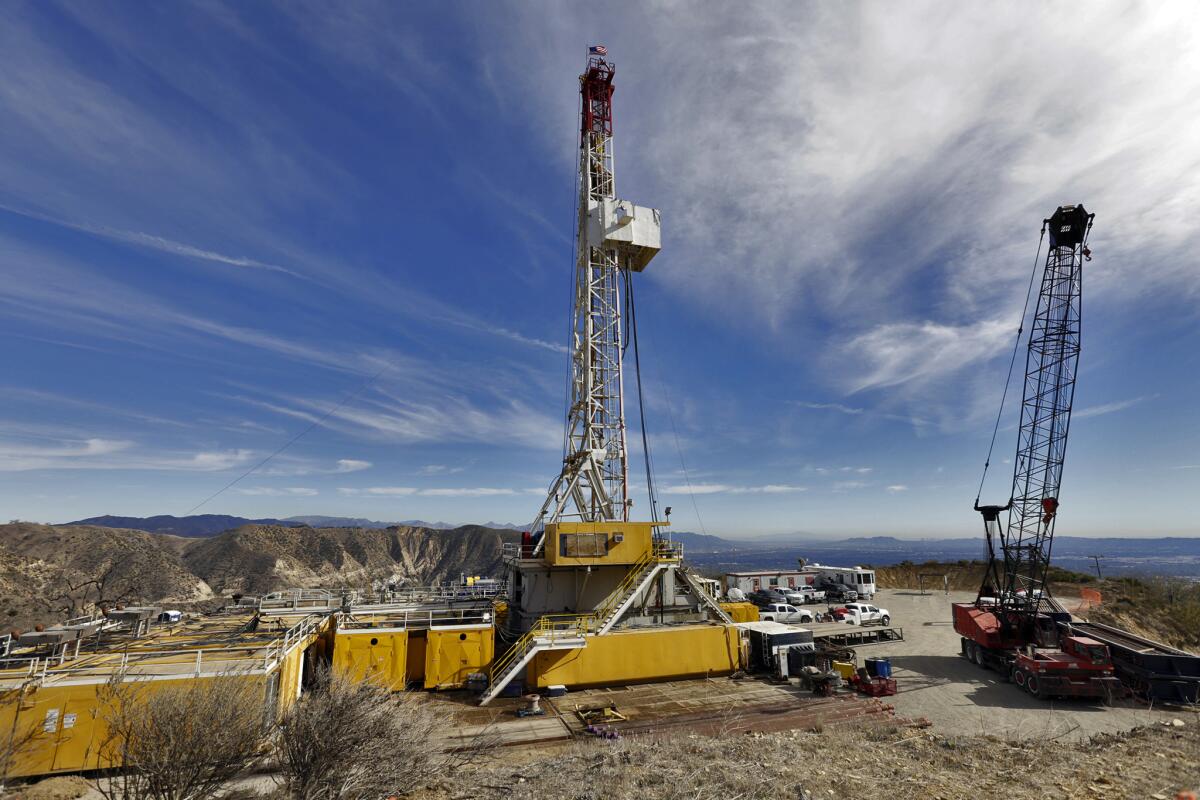Aliso Canyon gas leak exposes infrastructure vulnerabilities across country

- Share via
Crews are within days of declaring that a leaking gas well in Aliso Canyon has been sealed, but the impact of the environmental disaster that began last fall will continue to be felt now that it has exposed how much work America has to do to protect itself from aging infrastructure, the U.S. Energy secretary said Tuesday in a visit to the San Fernando Valley.
The leak in the country’s fifth-largest natural gas storage field underscores the broader themes of energy storage and infrastructure maintenance, Ernest Moniz told reporters after touring the site and meeting with local, state and federal politicians and regulatory agencies.
The meeting and media availability took place at the Chatsworth office of the Southern California Gas Co.
“These are issues that, I want to emphasize, have come to light particularly strongly here in Aliso Canyon and obviously are justifiably of huge local concern. But they also tell us about a problem we have to study more generally across the country and again that is part of why we are here,” Moniz said.
“Frankly, gas storage fields need a fresh look in terms of some of the regulatory requirements,” he said.
The Aliso Canyon gas leak, which was reported Oct. 23, prompted the temporary relocation of thousands of residents in Porter Ranch and surrounding communities. Residents complained of symptoms related to the odorants in the gas. Small businesses struggled to remain profitable. And questions remain about the long-term impact on property values.
Gas crews reached the leak Thursday. They injected fluids and then cement to seal the leak. Gas officials are now working with the state Division of Oil, Gas and Geothermal Resources on a series of tests to confirm that the well is permanently sealed, according to a spokesman for the utility.
Late Tuesday, the California Air Resources Board and Air Quality Management District announced an air monitoring plan for the Porter Ranch community.
The two agencies will specifically monitor for methane, mercaptans, benzene and hydrogen sulfide released from the Aliso Canyon storage field. Infrared cameras and aircraft will also be used to determine whether methane is escaping from SS-25.
Sen. Barbara Boxer (D-Calif.) announced last week that she wanted an agency, such as the management district, to conduct a study to determine what’s in the air once the natural gas leak is sealed.
The energy secretary’s visit came just days after Boxer met with Porter Ranch residents about the leak.
In an amendment to a federal energy bill last month, Boxer and Sen. Dianne Feinstein (D-Calif.) asked Moniz to lead a federal review into the cause and response to the gas leak. Moniz said that Tuesday’s visit will help shape that review, which may begin once the energy bill is approved.
Lawmakers are already reevaluating the safety standards for natural gas storage fields placed near homes.
A subsurface safety valve was removed from SS-25, the leaking well, in 1979. Southern California Gas Co. was not required to replace the valve because the storage field is more than 300 feet from the nearest home. A bill from state Sen. Fran Pavley (D-Agoura Hills) would require the installation of such valves on all wells.
Rep. Brad Sherman (D-Sherman Oaks) went another step and suggested infrared cameras be set up to monitor the storage field’s 115 wells. Data on how much methane and mercaptans are released should also be posted to a public website, he said.
“We’ve learned what we should have known, which is even if you’re a mile away, you have to be protected by safety valves and a host of other things,” the congressman said.
Twitter: @TheCityMaven
More to Read
Sign up for Essential California
The most important California stories and recommendations in your inbox every morning.
You may occasionally receive promotional content from the Los Angeles Times.














